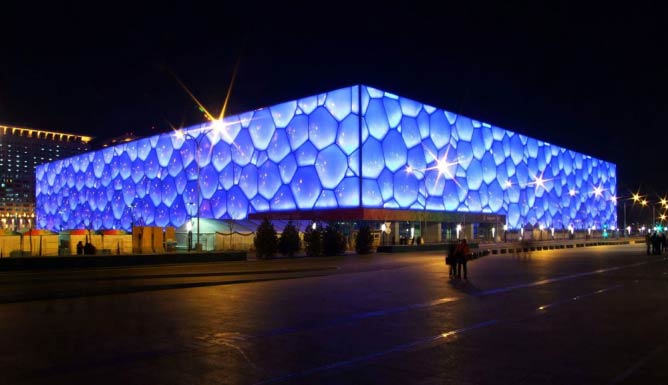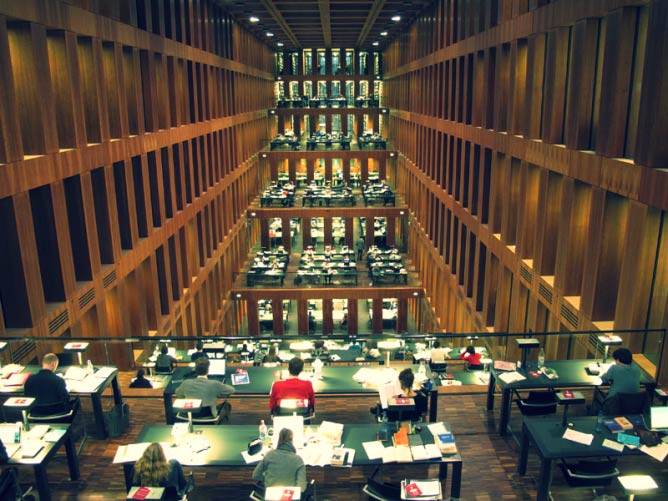Top 10 Contemporary German Architects You Should Know

Since Erich Mendelsohn, German architects have shown a real love for an organic building style, with innovation and technology reaching new heights and pushing the boundaries of architecture. Here are 10 of the best contemporary German architects every architecture lover should know.

3Deluxe
Proudly describing themselves as “Transdisciplinary Design,” 3Deluxe delivers impeccable style across interiors, graphics, interactive display, film and architecture. With the Leonardo Glass Cube in Bad Driburg, Germany makes the most of their transdisciplinary approach to design. The colors resemble the glass of the company’s jewelry, while the organic bands of white have all the drama of film. This building is not at all static – it is like liquid with a white web of elegant supports, stretching ceiling to roof, both inside and out. The combination of interior design, graphic design and architecture creates a complex and complete aesthetic entity with a spectacular presence.

With its unusual organic form (like bubbles in water) and a beautiful azure blue, the Beijing Watercube is surprisingly similar to 3Deluxe’s Leonardo Glass Cube. Rather than taking their inspiration directly from nature, LAVA creates new and exciting architectural forms from the natural geometric system and the golden ratio. Their website makes it clear that “green is the new black” and this really demonstrates the environmental aspects of their design. The cell-like cladding is a foam material that is 305 times more efficient than glass (in terms of heat and light penetration), making it one of the most eco-friendly stadiums in the world. Commissioned for the Beijing Olympics, the Watercube had to stand beside the iconic ‘Bird’s Nest’ National Stadium. The beautiful blue cubic design sets the building apart from its curvaceous neighbor, and makes a statement that belies the Olympic pools within.

J.Mayer.H
Architect and artist, Jürgen Mayer-Hermann provides a true sense of sculpture to his buildings. Located in the old quarter of Seville, Spain, the Metropol Parasol has become a much loved landmark of the city. At over 150m long and 26m high, this is quite possibly the largest wooden structure in the world. Despite initial controversy about costs and delays, the building has earned itself the affectionate name Las Setas de la Encarnación, or Incarnation Mushrooms, which has connotations of divinity and greatness in the original Spanish. As well as being the largest wooden structure, it is also likely to be the world’s most expensive parasol with an estimated cost of 100 million euros by its final completion. Regardless of expense, the elegant, natural curved lattice of the building make this a stunning addition to the architecture of Seville – the perfect refuge from the scorching Spanish sun.

Schneider+Schumacher
Frankfurt-based Schneider+Schumacher has gained international reputation for their innovative design; they have expanded across countries and continents, opening offices in Austria and China over the last few years. The Autobahn Church is a prime example of the ingenuity. Taking inspiration from traditional church form, with a nave and spire, the Autobahn church abstracts this shape creating something angular and futuristic. The harsh white concrete zig-zag of the exterior does not prepare you for the warm curvaceous wooden interior. Much like Mayer’s Metropol Parasol, wooden sheets are interlocked to create a smooth, womb-like interior that embraces the visitor with its warmth. The perfect blend of majesty and intimacy.

Graft Lab
Graft Lab are among Germany’s most renowned architects. Across five continents, they’ve been growing a great reputation for elegant, technology embracing design. Like a Modernist secret spy hideout, the Bird Island Villas in Kuala Lumpur are breathtaking family homes. With their environmental awareness, Graft Lab designed these villas with the warm climate in mind. Their vast shaded and ventilated outdoor areas surround a cooler living space while the silicon glass skin casts subtle shadows through its translucency, to balance the internal temperature. The dynamic shapes of the villas reflects the constant rippling movements of the nearby water, the perfect blend of architecture and environment.

Wurm+Wurm
Award-winning architects Wurm+Wurm follow the mantra “form follows site,” and they put the location at the heart of their work to create buildings that effortlessly embrace their surroundings. The fresh and modern Residence near Leipzig is a building that Le Corbusier would be proud of. On one side, a multi-cubed, geometric facade with large windows and glass balconies, on the other a great curve accentuated by darkly reflective ribbon windows with smaller apertures on the ground floor. The stark white and bluish-grey elements reflect the colors of the sea and sky while the curvilinear form mimics a great wave rolling on the ocean.

Finckh Architekten
Reinventing the traditional house shape of the Freiberg in Neckar village in Germany, House PP is a modern family home that breaks half the rules of conventional proportion. Built on a long narrow plot, the building appears like the hull of a ship plowing through the ocean. The sharp edges and clean, unornamented exterior at first appear plain, but a clustered windows and an unexpected asymmetric roof recess give the building a poetry and a sense of character that it might otherwise lack. All in all, Finckh Architekten has succeeded in creating a fully functional and pristine, elegant modern family home in Freiberg.

Max Dudler
Swiss-born architect, Max Dudler, set up his German firm in 1986 after completing his education in Berlin. His love of minimalism and classical rationalism has lead him to work on diverse projects, from modern office blocks to historical castles, creating ordered architecture for every location. Berlin has a rule where no building, except public buildings, may be over 22m tall; the Jacob and Wilhelm Grimm Center is one of Berlin’s best public libraries and towers above its neighbors at 38m in height establishing its authority as a place of civic academia. The smooth outer walls are pierced with regularly placed rectangles, most are even in size but at times they become much narrower to give some subtle variety. The intersecting planes and the even windows give a rhythm to the architecture which is also continued in the interior. Warm wood cladding, white-washed walls and black book cases all follow the same rigorous geometric pattern unifying the space with its repeating book-like rectangles – a calming and suitable place for a library.

Kadawittfeldarchitektur
Kadawittfeldarchitektur pride themselves on finding the “hidden potential” in construction to make a space as functional as possible, both in a utilitarian way and in a social environmental way. Kita Troplo Kids der Beirsdorf AG is the perfect embodiment of a children’s playschool. Comprised of black and brightly-colored interlocking frames, the building resembles a child’s toy block construction while creating a fun, engaging backdrop for their early development. This multicolored two-story building is a rhythm of space and void, walls and glass injected with playful crayon-like colors that embody and captivate its childhood consumer. Kadawittfeldarchitektur has succeeded in creating a dynamic early learning environment for the children of Hamburg.

Franken Architekten
Franken Architekten endeavor to create “narrative spaces” that expand the realms of functionality with striking designs and a touch of fantasy. The building, Bubble, tries to mimic the form of a water droplet. This often-overlooked symbol is universally familiar, evocative of tears, rain and the water in our daily lives. By day, Bubble has a glassy smooth surface that reflects and distorts its surroundings, but after dark, the building comes alive with bright pink, purple and blue lighting glowing within. This striking building was the first in the world to be “completely created with digital means.” Design and construction were achieved thanks to technological pioneers in the world of architecture and this little Bubble of architecture will now forever be a landmark of design and innovation.
By Tamsin Nicholson
Tamsin Nicholson is currently studying Art History in Glasgow. With the Royal Naval Reserves, she sails to off-the-beaten track costal locations. Her keen interest in art and culture has taken her through Europe by train and across the Atlantic. Find her at www.theladytraveller.net.
Since you are here, we would like to share our vision for the future of travel - and the direction Culture Trip is moving in.
Culture Trip launched in 2011 with a simple yet passionate mission: to inspire people to go beyond their boundaries and experience what makes a place, its people and its culture special and meaningful — and this is still in our DNA today. We are proud that, for more than a decade, millions like you have trusted our award-winning recommendations by people who deeply understand what makes certain places and communities so special.
Increasingly we believe the world needs more meaningful, real-life connections between curious travellers keen to explore the world in a more responsible way. That is why we have intensively curated a collection of premium small-group trips as an invitation to meet and connect with new, like-minded people for once-in-a-lifetime experiences in three categories: Culture Trips, Rail Trips and Private Trips. Our Trips are suitable for both solo travelers, couples and friends who want to explore the world together.
Culture Trips are deeply immersive 5 to 16 days itineraries, that combine authentic local experiences, exciting activities and 4-5* accommodation to look forward to at the end of each day. Our Rail Trips are our most planet-friendly itineraries that invite you to take the scenic route, relax whilst getting under the skin of a destination. Our Private Trips are fully tailored itineraries, curated by our Travel Experts specifically for you, your friends or your family.
We know that many of you worry about the environmental impact of travel and are looking for ways of expanding horizons in ways that do minimal harm - and may even bring benefits. We are committed to go as far as possible in curating our trips with care for the planet. That is why all of our trips are flightless in destination, fully carbon offset - and we have ambitious plans to be net zero in the very near future.
- Post ID: 360114
- Sponsored? No
- View Payload












